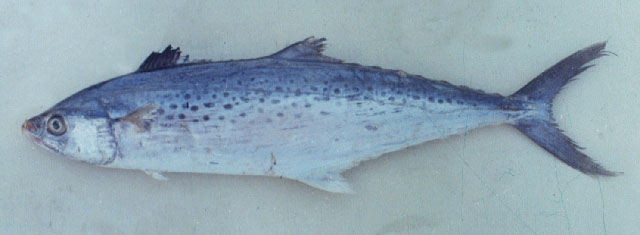| Scombridae (Mackerels, tunas, bonitos), subfamily: Scombrinae |
| 81.5 cm FL (male/unsexed); max.weight: 4,000.0 g |
|
pelagic-neritic; brackish; marine; depth range 15 - 200 m, oceanodromous |
| Indo-West Pacific: Persian Gulf, India and Sri Lanka (Ref. 9684) to southeast Asia, north to Hong Kong and Wakasa Bay, Sea of Japan. |
|
Dorsal spines (total): 15-18; Dorsal soft rays (total): 18-24; Anal spines: 0-0; Anal soft rays: 19-23; Vertebrae: 47-52. Interpelvic process small and bifid. Swim bladder absent. Body entirely covered with small scales. Lateral line with many auxiliary branches extending dorsally and ventrally in anterior third, curving down toward caudal peduncle. Intestine with 2 folds and 3 limbs. Sides silvery white with several rows of round dark brownish spots scattered in about three irregular rows along the lateral line. First dorsal fin membrane black. |
| A pelagic migratory fish inhabiting coastal waters at depths between 15-200 m; sometimes entering turbid estuarine waters; usually found in small schools (Ref. 9684). Feeds mainly on small schooling fishes (especially sardines and anchovies), squids and crustaceans (Ref. 9684). Fishing peaks in the months of November and December in Eastern Thailand, late Dec and January in the northern part of the Gulf and January to March in its western part. Caught with midwater trawls, purse seines, bamboo stake traps, and by trolling (Ref. 9684). Marketed mainly fresh; also dried-salted (Ref. 9684), smoked and frozen (Ref. 9987). Small quantities of frozen product are exported to Europe and North America (Ref. 9987). |
|
Data deficient (DD); Date assessed: 04 December 2009 Ref. (130435)
|
| harmless |
Source and more info: www.fishbase.org. For personal, classroom, and other internal use only. Not for publication.
